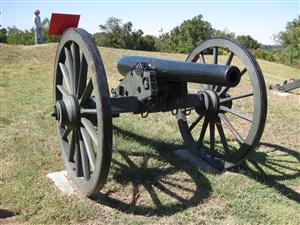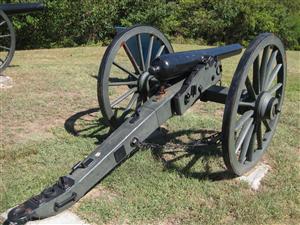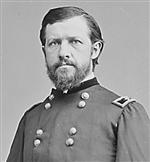Artillery Platform: 3-inch Ordnance Rifle (10 on map)
Tour Stop


Directions: This artillery platform [ Waypoint = N37 37.172 W90 38.376 ] holding a 3-inch Ordnance Rifle was located along the southeastern wall of Fort Davidson. Continue walking clockwise on the top of the fort's parapet and stop about one third of the way to the next angle.
 Description: You should be able to see the remnants of the artillery platform. Battery H, Second Missouri Light Artillery under the command of Captain William C. F. Montgomery consisted of six 3-inch Ordnance Rifles and was part of Ewing's command at Fort Davidson. In his official report, Brigadier-General Thomas Ewing, Jr. wrote about building artillery platforms for the field artillery he had at his disposal. [110]
Description: You should be able to see the remnants of the artillery platform. Battery H, Second Missouri Light Artillery under the command of Captain William C. F. Montgomery consisted of six 3-inch Ordnance Rifles and was part of Ewing's command at Fort Davidson. In his official report, Brigadier-General Thomas Ewing, Jr. wrote about building artillery platforms for the field artillery he had at his disposal. [110]
"Details were set at work constructing in the fort six platformed barbettes for the field artillery, four pieces of which were taken into it. Lieut. David Murphy, Forty-seventh Missouri Volunteers, a most gallant officer and experienced artillerist, was assigned to duty on my staff as aide-de-camp and given general control of the artillery."
Brigadier-General Ewing sent one Section (two guns) of Battery H south to Ironton to support the detachments of cavalry and infantry south of the fort. Lieutenant T. M. Montgomery wrtoe about what Ewing did with the other four field pieces. [111]
"About sundown, Lieutenant Simonton was sent with the first section of Battery H and with other forces to Ironton, where they remained until about midnight when they fell back to a position near the fort. When Simonton's section went to Ironton the other four guns were ordered inside the fort, and the men set to work throwing up earth embankments for the guns, so that they might fire over the parapet. It took the greater part of the night to get the guns mounted. After the embankments had been built high enough they were overlaid with planks, then ropes were tied around the gun axles and secured to the revetments of the earthworks to keep the recoil from running the guns off the embankments. In action the men at these guns were exposed from their waists up."
Back: Artillery Platform: 32-pounder Siege Gun (9 on map)
Next: Artillery Platform: 3-inch Ordnance Rifle (11 on map)
